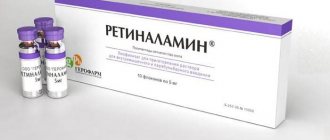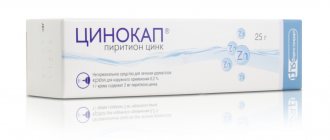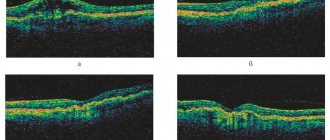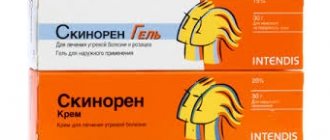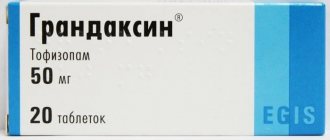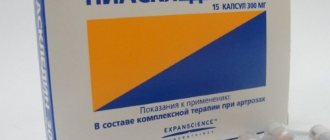Ethosuximide is an antiepileptic drug belonging to the succinimides group, especially effective in the treatment of absence seizures that are not accompanied by other types of seizures. This drug is included in the list of essential drugs according to WHO.
The most popular drugs based on ethosuximide are Suxilep, Petnidan and Zarontin; all medications have a similar mechanism of action on the body, almost identical indications and side effects.
All drugs contain the active substance ethosuximide, as well as impurity components, including macrogol, E110, titanium dioxide, gelatin, water and others.
Medicines are available in the form of syrup, drops and capsules.
Pharmacological properties
Ethosuximide inhibits synaptic transmission in certain areas of the brain, thereby reducing seizure activity and the number of seizures in the patient. They act as an analgesic for neuralgia and some other neurological diseases.
The active substance is absorbed almost completely. The effective concentration in blood plasma is 40-100 mcg/ml. At concentrations greater than 150 mcg/ml, toxic reactions may occur.
The state of “equilibrium” occurs after 8-10 days after starting to take the capsules. The liver processes the active component into monomers, which are excreted by the kidneys. 10-20% are output unchanged.
Brief characteristics of analogues
Petnidan is a drug based on ethosuximide from a well-known German pharmaceutical company, which guarantees the effectiveness and quality of its drugs. This is one of the main antiepileptic drugs prescribed mainly to children. It is used for many types of juvenile and childhood epilepsy. Can be used as adjunctive therapy.
The medicine is introduced into the course of treatment gradually, with constant monitoring of the patient’s condition. Petnidan has multiple side effects, namely: nausea, dizziness, migraine, abdominal pain, weight loss, diarrhea, unstable emotional state, and possible allergic reactions to the drug.
Zarontin is an antiepileptic medication that is prescribed for the treatment of epilepsy, triangular neuralgia and for the relief of many types of seizures. It has a more impressive list of side effects than other drugs based on ethosuximide.
Suxilep is the most effective medicine among analogues based on ethosuximide. Prescribed for the treatment of epilepsy and for the relief of various types of seizures. The drug has the same list of side effects. Let's take a closer look at its characteristics.
Scope of application and contraindications
Susilep is indicated for use in:
- absence seizures;
- epileptic seizures;
- convulsive syndrome;
- myoclonic seizures;
- trigeminal neuralgia (in complex therapy).
You should not take the medicine:
- if the child is under six years of age;
- during lactation;
- if the patient is diagnosed with hypersensitivity to the active substance;
- for mental illness;
- with renal or liver failure.
Indications for use
attacks of pycnoleptic absence seizures, as well as complex and atypical convulsive seizures (to avoid the development of generalized tonic-clonic seizures, which often aggravate the course of complex and atypical convulsive seizures, you can use a combination of ethosuximide with anticonvulsants (for example, primidone, phenobarbital). Additional prevention of generalized tonic-clonic seizures clonic seizures can be performed without exception in the case of pycnoleptic absence attacks in school-age children); myoclonic-astatic small seizures (petit mal); juvenile myoclonic seizures (impulsive petit mal seizures).
Recommended Dosages
The drug should be taken before or during meals; the capsules should be washed down with plenty of water. The attending physician selects the dosage for each patient individually, based on the general picture of the disease and the characteristics of the patient’s body.
Therapy begins with small doses of ethosuximide, and the dosage is increased over time.
The daily dose is calculated in direct proportion to the patient's weight. For children over 12 years old and adults:
- up to 50 kg – from 750 to 1500 mg;
- from 67 kg – from 1000 to 2000 mg;
- from 83 kg – from 1250 to 2500 mg.
For children under twelve years of age:
- up to 13 kg – from 250 to 500 mg;
- from 25 kg – from 500 to 1000 mg;
- from 38 kg – from 750 to 1500 mg;
- from 50 kg – from 1000 to 2000 mg.
The treatment period is usually long. The duration of the course can only be determined by the attending physician. The dose should be reduced only if seizures do not appear for several years.
The drug is withdrawn gradually. This process usually takes one or two years, depending on the patient's condition.
Adverse reactions
When taking the drug, you should be careful with the dosage, since if it is exceeded, numerous side effects are possible:
- cephalgia;
- migraine;
- nausea;
- diarrhea;
- abdominal pain;
- hallucinations;
- severe fatigue;
- aggressiveness;
- weight loss;
- allergic reactions on the skin;
- insomnia;
- depression;
- constipation;
- ataxia.
The most common adverse reactions are nausea and vomiting.
This drug has a fairly wide list of side effects, but they occur quite rarely. If you adhere to a special diet, do not drink alcohol and monitor the level of drug concentration in the blood plasma, then the danger will pass.
Similar drugs:
- Neurotropin (neurotrophin) Solution for injection
- Magnesium sulfate Powder for oral suspension
- Magnesium sulfate Substance-powder
- Celandine grass (Chelidonii majoris herba) Vegetable raw materials
- Xanax Oral tablets
- Rivotril Oral tablets
- Neurox Solution for intravenous and intramuscular administration
- Tebantin Capsule
- Phenazepam Solution for intravenous and intramuscular administration
- Benzonal Oral tablets
** The Drug Directory is intended for informational purposes only. For more complete information, please refer to the manufacturer's instructions. Do not self-medicate; Before starting to use the drug Suxilep, you should consult a doctor. EUROLAB is not responsible for the consequences caused by the use of information posted on the portal. Any information on the site does not replace medical advice and cannot serve as a guarantee of the positive effect of the drug.
Are you interested in the drug Suxilep? Do you want to know more detailed information or do you need a doctor's examination? Or do you need an inspection? You can make an appointment with a doctor - the Euro lab is always at your service! The best doctors will examine you, advise you, provide the necessary assistance and make a diagnosis. You can also call a doctor at home . Euro lab clinic is open for you around the clock.
** Attention! The information presented in this medication guide is intended for medical professionals and should not be used as a basis for self-medication. The description of the drug Suxilep is provided for informational purposes only and is not intended for prescribing treatment without the participation of a doctor. Patients need to consult a specialist!
If you are interested in any other drugs and medications, their descriptions and instructions for use, information about the composition and form of release, indications for use and side effects, methods of use, prices and reviews of drugs, or you have any other questions and suggestions - write to us, we will definitely try to help you.
Special patients
If the expectant mother takes Suxilep during pregnancy, there is a chance that the child will have developmental defects. Constant monitoring of the condition of the mother's body is necessary.
If there is an urgent need, the medication should be prescribed in doses individual to the patient on certain days of pregnancy. The safest period for using the medicine during pregnancy is the period between the twentieth and fortieth day.
If you become pregnant, you should immediately consult your doctor.
Ethosuximide is excreted in milk, so breastfeeding is not permissible.
Admission in childhood
Preparations based on ethosuximide are specifically intended for children. But there is an age limit; only from the age of six can a child begin taking these medications. Dosage is determined by the attending physician.
Use during pregnancy
Ethosuximide is known to increase the risk of intrauterine malformations. However, discontinuation of the drug during pregnancy is associated with an increased likelihood of seizures and spontaneous termination. Therefore, pregnant women do not discontinue the drug, but reduce the dosage to the minimum effective. It is also recommended to avoid the combined use of several antiepileptic drugs. Breastfeeding during treatment with Suxilep is not allowed.
You can buy the drug in one of the 5 thousand pharmacies presented on our website. Book the product at the location closest to your home and pick it up at a convenient time.
special instructions
During therapy, it is necessary to abstain from alcohol, as this can lead to undesirable consequences for the patient’s body.
In case of renal or liver failure, taking the medicine is not recommended. The active substance is excreted due to the work of the kidneys and liver. If the organs do not cope, then a certain percentage of the substance will remain in the blood plasma. Excessive accumulation of the product can lead to overdose.
An individual course of therapy is developed for such patients. Dosage is determined by the attending physician.
Ethosuximide does not cause changes in the concentrations of other drugs in the patient's blood. Sometimes phenytoin levels increase.
Carbamazepine and valproic acid may affect the concentration of the active substance.
If you take drugs that affect the functioning of the central nervous system together with Suxilep, their sedative properties increase.
Patients' opinions
Reviews from patients who took Suxilep and its analogues based on ethosuximide to relieve various types of seizures.
We have been using Suxilep as active therapy for several years now. We took the medicine for a while and became very irritable. The medicine has a terrible taste and can cause stomach irritation and vomiting. I add the product to purees and porridges.
Nina, Alyosha's mother
It has a vile taste, so the child often vomited. There were no more side effects. We learned about the imported analogue Petnidan, which is sold in the form of syrup and drops. The syrup is easy to drink, but this medicine did not work for us.
Lara
He helped us. But still, it tastes quite unpleasant, so much so that the child vomited. It is necessary to drink plenty of clean water. To avoid nausea, take half a capsule with food.
Katerina Leonidovna, 48
For four years now we have been registered with a doctor with a diagnosis of epilepsy. Relatively recently we switched to Suxilep. It is much more effective than the drugs we used before.
The attacks have become much less, and this is noticeable. During the use of the medicine, we found only one problem - an unbearable taste. The taste is very pungent, sometimes the child cannot stand it, he feels sick and vomits. An extremely unpleasant moment.
To prevent this from happening, I started giving out half a capsule every time before meals. I put part of the capsule in porridge and purees, the child eats it and does not feel this vile taste.
Alena, 27
Doctor's opinion:
Conclusions from the words of experienced...
This is a very effective antiepileptic drug that helps cope with seizures. The drug tastes terrible, many patients cannot take it because vomiting immediately occurs.
Ethosuximide-based drugs are often recommended by doctors. The majority of patients who took the drug had no side effects other than vomiting and abdominal pain.
A.S. Petrukhin, M.B. Mironov, K.Yu. Mukhin Department of Neurology and Neurosurgery, Faculty of Pediatrics, State Educational Institution of Higher Professional Education, Russian State Medical University of the Republic of Health, Moscow
Suxilep has been used to treat epilepsy since the 60s of the last century. Traditionally, Suxilep is considered as the drug of choice in the treatment of absence seizures in childhood absence epilepsy. And, unfortunately, historically there has been a false opinion that Suxilep (ethosuximide) has a narrow spectrum of effectiveness, which undeservedly limits its use in epileptology. In our review, based on personal experience and data from studies conducted around the world, we tried to show that the role of Suxilep in the treatment of epilepsy is much broader. Suxilep - the chemical name is ethosuximide, 2-ethyl-2-methylsuccinimide belongs to the group of succinimides. The main mechanism of action is the effect on the metabolism of gamma-aminobutyric acid, which leads to a decrease in paroxysmal neuronal discharges, blockade of T-type Ca channels, and also directly affects the transmitter mechanisms of corticothalamic seizures. As mentioned above, Susilep is most effective against typical absence seizures. Typical absence seizures are short, generalized epileptic seizures characterized by sudden onset and termination. According to the definition, absence seizures consist of two main components: clinically there is a disturbance of consciousness, which is accompanied by electroencephalographic changes in the form of generalized discharges of acute-slow wave complexes, with a frequency of 3 or more hertz (J. Jr. Engel, 2001). Numerous studies have shown that complete relief of absence seizures with the use of Suxilep is observed in 50% of cases, and in 40-45% their significant reduction is observed (Browne et al. 1975; Berkovic et al. 1987). This type of seizure occurs in idiopathic generalized forms of epilepsy. With the classic picture of childhood absence epilepsy (CAE), characterized by typical absence seizures with an age of onset of about 8 years and in the absence of generalized convulsive seizures (GSE) in the clinical picture, monotherapy with Suxilep is possible (K.Yu. Mukhin et al., 2008; SF Berkovic, 2005). In most cases with DAE, the effectiveness of ethosuximide is clearly higher, and tolerability is better than that of valproate (K.Yu. Mukhin et al., 2008). When combining absence seizures in combination with GSP for DAE, Suxilep is used only in combination with valproate, and the drug valproic acid is the base drug, and Suxilep is an additional one (K.Yu. Mukhin et al., 2008). In juvenile absence epilepsy (JAE), the onset of absence seizures varies from 9 to 21 years, with an average of 12.5 years. Absence seizures with JAE are usually shorter in duration and less frequent in frequency than with DAE. Characteristic is the addition of GSP, which are detected in 65-90% of patients. Juvenile absence epilepsy differs from DAE by being more resistant. Taking into account the presence of generalized convulsive seizures in the clinical picture, basic therapy is carried out with broad-spectrum drugs, such as valproate, topiramate, levetiracetam. For treatment-resistant absence seizures, a good effect is observed when Suxilep is used as an additional drug (K.Yu. Mukhin et al., 2008; P. Wolf, Y. Inoue, 1984). It should be noted that, despite a small number of studies on the comparative effectiveness of antiepileptic drugs in the initial monotherapy of childhood and adolescent absence epilepsy, a number of authors believe that ethosuximide is not inferior in effect to valproate (T. Glauser et al., 2006). WM Burnham suggests prescribing ethosuximide as the first choice drug in the treatment of juvenile absence epilepsy with onset of absence seizures, since it is more easily tolerated than valproate by children and women of childbearing age (WM Burnham, 1998). Of interest is the study by S. Sato et al., who showed that ethosuximide and valproate are equally effective in relieving not only absence seizures, but also generalized peak-wave discharges in patients with absence forms of epilepsy (S. Sato et al., 1982). In the treatment of juvenile myoclonic epilepsy, characterized by the age of onset in puberty, the presence of myoclonic seizures, DBS and absence seizures, it is also possible to use succinimides as an additional therapy, which includes Susilep (K.Yu. Mukhin et al., 2008; DL Hurst, 1996) . Other forms of idiopathic generalized epilepsy, such as benign myoclonic epilepsy of infancy, myoclonic-astatic epilepsy, and myoclonic absence epilepsy, have shown good efficacy of ethosuximide as an adjunctive therapy (Wolf and Inoue 1984; Wallace 1998; Perucca 2001). Moreover, it is important to note that we are talking not only about absence seizures, but also about epileptic myoclonus. Epilepsy with myoclonic absence seizures (EMA) differs from classical absence forms of epilepsy. The level of change in consciousness during myoclonic absence may fluctuate from complete shutdown to moderate, at which the patient can continue activities. At the time of an absence attack, rhythmic myoclonic shudders are observed, involving the shoulder girdle, arms, and, less often, the lower limbs. The frequency of myoclonic absences is high, and a status-like course is possible, especially in the morning. The prognosis for epilepsy with myoclonic absence seizures is quite serious. Seizures can be stopped in approximately half of patients; in most cases there are cognitive impairments of varying severity. Most authors who have studied this syndrome agree that the combination of valproate and ethosuximide is most effective in the treatment of myoclonic absence seizures (K.Yu. Mukhin et al., 2008; M. Bureau, CA Tassinari, 2005; SJ Wallace, 1998). V. Manonmani et al. and SJ Wallace showed a good effect of the combination of ethosuximide and lamotrigine in the treatment of UAE (V. Manonmani et al, 1994; SJ Wallace, 1998). In myoclonic-astatic epilepsy (Doose syndrome), the main types of seizures are myoclonic and myoclonic-astatic seizures. Often the addition of absence seizures and GSP. It is possible to develop a non-convulsive status. Cognitive impairment is observed in half of the cases. According to R. Guerrini et al., the use of ethosuximide in the treatment of Doose syndrome can be very effective in cases where epileptic myoclonus and absence seizures predominate in the clinical picture, which is consistent with our data (K.Yu. Mukhin et al., 2008; R. Guerrini et al, 2005). Benign myoclonic epilepsy of infancy, a rare form of idiopathic generalized epilepsy, debuts in the first years of life and is characterized by myoclonic seizures and a good prognosis. In most cases, the use of valproate allows for complete relief of attacks. However, if the effect is insufficient, photosensitivity is detected or absence seizures occur at a later age, the use of Suxilep as a second drug is justified (K.Yu. Mukhin et al., 2008; C. Dravet et al., 2005). The role of Suxilep in the treatment of severe forms of epilepsy is also well known, which, according to the draft new classification, are usually classified as epileptic encephalopathies. These forms are often called catastrophic epilepsies, since they often lead to profound disability in patients. In the occurrence of pronounced cognitive and mental disorders in this group of epilepsies, not only frequent treatment-resistant seizures play a role, but also continued epileptiform discharges on the EEG (J. Jr. Engel; ILAE, 2001). Lennox-Gastaut syndrome (LGS) begins in childhood. LSH is characterized by tonic, atonic seizures, atypical absences, DBS, pronounced diffuse epileptiform activity on the EEG in the form of slow acute-slow wave complexes. With the onset of the disease, mental development is delayed. With the dominance of resistant atypical absence seizures in the clinical picture of LGS and the development of non-convulsive status, most authors propose a combination of Suxilep and valproates as second-line drugs (A.S. Petrukhin, 2000; Ohtsuka et al. 2006; Schmidt and Bourgeois, 2000). A number of authors note that ethosuximide in LGS can be effective not only in atypical absence seizures, but also in the control of myoclonic and atonic seizures (CP Panayiotopoulos, 2005; OS Snead et al., 1987). The dose of Suxilep is increased once every 3 days (maximum dose - 30 mg/kg body weight per day) regardless of the dose of valproate (A.S. Petrukhin, 2000). Severe myoclonic epilepsy of infancy (Dravet syndrome) debuts in the first year of life with prolonged generalized or unilateral clonic seizures provoked by high temperature. As the disease progresses, myoclonic (focal or generalized), focal motor seizures, GSP, and atypical absence seizures appear. Characterized by a high frequency of attacks, their serial and status course. Photosensitivity is detected in 42% of cases. The prognosis is unfavorable: all patients have cognitive impairment and a high mortality rate. In the treatment of myoclonic syndrome, including the status of myoclonic seizures and atypical absences, according to S. Dravet, it is possible to use ethosuximide as an additional drug (C. Dravet et al., 2005). K.Yu. Mukhin et al. (2008) reported a possible combination of valproate and Suxilep in the treatment of West syndrome in cases of flexor myoclonic spasms and the predominance of hypsarrhythmia in the occipital regions (K.Yu. Mukhin et al., 2008). Pseudo-Lennox syndrome is characterized by the appearance in childhood of polymorphic seizures: focal motor, secondary generalized convulsive, myoclonic seizures, as well as atypical absences and negative myoclonus. As the disease progresses, all patients develop severe cognitive and speech disorders, which greatly complicate their learning. Suxilep has been shown to be highly effective in relieving negative myoclonus and atypical absences in this syndrome (K.Yu. Mukhin et al., 2008; H. Oguni H. et al., 1998; Rubboli and Tassinari 2006). In our opinion, it is recommended to add Suxilep to basic AEDs immediately after the ineffectiveness of monotherapy. Suxilep is prescribed at a dose of 500-1000 mg/day (20-35 mg/kg/day) in 3 divided doses. This combination is especially effective against pseudogeneralized seizures (atonic, myoclonic, atypical absences) and continued diffuse epileptiform activity on the EEG (K.Yu. Mukhin et al., 2008). In the group of epileptic encephalopathies, a special place is occupied by forms of epilepsy, united by the term cognitive epileptiform disintegration. With these forms of epileptic seizures there may not be any or they are isolated in the history, but due to continued epileptiform activity during sleep in the clinical picture, cognitive, mental and behavioral disorders increase as the disease progresses, which can cause significant disability in patients. The best known forms in this group are Landau-Kleffner syndrome and electrical status epilepsy of slow-wave sleep. Epilepsy with electrical status epilepticus of slow-wave sleep (EESM) is characterized by the presence of both focal and generalized epileptic seizures in combination with severe cognitive impairment and an EEG pattern of continued diffuse epileptiform activity during slow-wave sleep, continuing continuously for many months. At least 20% of patients do not have epileptic seizures, both according to the anamnesis and during follow-up observations (K.Yu. Mukhin et al., 2008). With Landau-Kleffner syndrome, speech disorders come to the fore. At the onset of the disease (regardless of the onset of attacks), manifestations of sensory aphasia are noted, followed by a complete cessation of speech. In our opinion, Suxilep can be the first choice drug for cognitive epileptiform disintegrations (K.Yu. Mukhin et al., 2005, 2008). Suxilep has been shown to be highly effective against continued diffuse epileptiform activity during sleep (K.Yu. Mukhin et al., 2005, 2008; Li Ming, 1996; CP Panayiotopoulos, 2005). As monotherapy, the prescription of Suxilep is justified in the absence of motor attacks; if attacks occur, ethosuximide can be prescribed as an additional drug to basic therapy. Progressive myoclonus epilepsy (PME) is a hereditary degenerative disease of the central nervous system. In many of them, pathological genes that determine the development of the disease have been verified. In the treatment of progressive forms of epilepsy with myoclonus, many AEDs have been tested without significant effect or with temporary improvement. However, a number of authors report the positive effect of Suxilep on negative myoclonus, which can often be combined with myoclonic seizures in PME (Oguni et al, 1998; SJ. Wallace, 1998). Ethosuximide has been shown to be effective as an adjunctive drug against myoclonic seizures in various forms of epilepsy associated with epileptic myoclonus (Wallace SJ, 1998). SJ Wallace in his article showed that the combination of valproate and ethosuximide is very effective in the treatment of epileptic myoclonus of the eyelids with absence seizures (Wallace SJ., 1998). Photosensitive forms of epilepsy are characterized by the provocation of attacks by rhythmic light. Resistance to AEDs is often observed. A number of authors report a good effect of ethosuximide in the treatment of generalized seizures, especially absence seizures, in photosensitivity forms of epilepsy (Covanis A. et al, 2004; Jeavons et al., 1975). In symptomatic focal epilepsy with the phenomenon of secondary bilateral synchronization, along with “classical” focal seizures, pseudogeneralized seizures occur, which have the kinematic characteristics of generalized, diffuse ictal EEG patterns, but are focal by the mechanism of occurrence (Mukhin K.Yu. et al., 2006) . These include atypical absences, atonic, myoclonic seizures (Blume et al, 1985). Our work (Mukhin K.Yu. et al., 2006) shows the high effectiveness of Suxilep against pseudogeneralized seizures (excluding tonic ones) and blocking frequent diffuse discharges on the EEG. There are reports showing high effectiveness in the treatment of epilepsy in children with chromosomal disorders associated with epilepsy. I would especially like to note the effectiveness of Suxilep in the treatment of epilepsy in children with Angelman syndrome (AS). Angelman syndrome (“happy doll syndrome”, happy puppet syndrome) is a chromosomal syndrome associated with a pronounced delay in psycho-speech development, epileptic seizures, as well as with a special, “happy” behavior of patients combined with outbursts of laughter. Resistant epilepsy develops in 90% of cases. In AS, most patients have a deletion of the maternal chromosome 15q11-13, which is responsible for the synthesis of aminobutyrate A receptor genes (GABAA). In this regard, the effectiveness of antiepileptic drugs with GABAergic effects is being studied. A good effect of ethosuximide has been shown against atypical absence seizures and myoclonic status in patients with Angelman syndrome (Laan LA, 1996; Sugiura C, 2001). Moreover, in most cases, when using ethosuximide, it is possible to stop not only absence attacks, but also to achieve a significant reduction in diffuse discharges on the EEG (Sugiura C, 2001). A good effect has been observed with the combination of valproate and ethosuximide (Viani F et al., 1995). ML Silva reports good results from treatment with ethosuximide in patients with Down syndrome and early-onset epilepsy (Silva ML et al, 1996). Thus, in a group of patients who had a transformation of West syndrome with the appearance of myoclonic, atonic seizures and headaches, the use of valproate and ethosuximide allowed to achieve remission in most cases (Silva ML et al, 1996).
Thus, our review shows the high effectiveness of Suxilep (ethosuximide) in the treatment of many forms of epilepsy. Suxilep is effective in relieving typical and atypical absence seizures, myoclonic seizures, negative myoclonus, epileptic myoclonus of the eyelids with absence seizures, and pseudogeneralized seizures. Further studies to study the effectiveness of Suxilep in various epileptic syndromes are promising.
Literature 1. Mukhin K.Yu., Mironov M.B., Tysyachina M.D., Alikhanov A.A., Petrukhin A.S. Electro-clinical characteristics of patients with symptomatic focal epilepsy with the phenomenon of secondary bilateral synchronization on the EEG. // Russian Journal of Child Neurology, 2006, volume 1 issue 1, 6-17 2. Mukhin K.Yu., Petrukhin A.S. Idiopathic forms of epilepsy: taxonomy, diagnosis, therapy. – M: Art-Business Center, 2000. 3. Mukhin K.Yu., Petrukhin A.S., Kalinina L.V., Rykova E.A. Typical absence seizures: clinical systematization and therapy // Practical Bulletin. neurol. 1995. T. 1 No. 1. 30-40. 4. Mukhin K.Yu., Petrukhin A.S., Mironov M.B. "Epileptic syndromes. Diagnostics and therapy". A reference guide for doctors. Moscow, 2008, 223. 5. Mukhin K.Yu., Petrukhin A.S., Mironov M.B., Kholin A.A., Glukhova L.Yu., Pilia S.V., Volkova E.Yu., Golovteev A.L., Pylaeva O.A. Epilepsy with electrical status of slow-wave sleep: diagnostic criteria, differential diagnosis and approaches to therapy // Moscow, 2005 6. Petrukhin A.S. Lennox-Gastaut syndrome // Idiopathic forms of epilepsy: systematics, diagnosis, therapy / Ed. Mukhin K.Yu., Petrukhin A.S. M: Art-Business Center, 2000. 7. Berkovic SF (2005) Treatment with anti-epileptic drugs. Aust Fam Physician 34(2):1017–1020. 8. Berkovic SF, Andermann F, Andermann E, Gloor P (1987) Concepts of absence epilepsies: Discrete syndromes or biological continuum. Neurology 37: 993–1000. 9. Blume WT & Pillay N. Electroencephalographic and clinical correlates of secondary bilateral synchrony // Epilepsia, 1985. V. 26/6 P. 636-641. 10. Browne TR, Dreifuss FE, Dyken PR, Goode DJ, Penry JK, Porter RJ, White BG, White PT (1975) Ethosuximide in the treatment of absence (petit mal) seizures. Neurology 25: 515-524. 11. Bureau M., Tassinari CA The syndrome of myoclonic absences // In: Epileptic syndromes in infancy, childhood and adolescence. – Fourth Edition/Eds. Roger R., Bureau M., Dravet Ch., Genton P., Tassinari CA, Wolf P./John Libbey. 2005. p. 343. 12. Burnham, W. M. (1998). Antiseizure drugs (anticonvulsants). In H. Kalant, & WHE 13. Covanis A, Stodieck SR, Wilkins AJ (2004): Treatment of photosensitivity. Epilepsia 45 (S1): 40-45 14. Dravet C., Bureau M. Benign myoclonic epilepsy in infancy // In: Epileptic syndromes in infancy, childhood and adolescence. – Fourth Edition/Eds. Roger R., Bureau M., Dravet Ch., Genton P., Tassinari CA, Wolf P./John Libbey. 2005. p. 84 15. Dravet C., Bureau M., Oguni H., Fukuyama, Cocar O. Severe myoclonic epilepsy in infancy (Dravet syndrome).// In: Epileptic syndromes in infancy, childhood and adolescence. – Fourth Edition/Eds. Roger R., Bureau M., Dravet Ch., Genton P., Tassinari CA, Wolf P./John Libbey. 2005. p. 100 16. Engel J Jr; International League Against Epilepsy (ILAE). A proposed diagnostic scheme for people with epileptic seizures and with epilepsy: report of the ILAE Task Force on Classification and Terminology. Epilepsy. 2001 Jun; 42 (6): 796-803. 17. Glauser T, Ben-Menachem E, Bourgeois B, Cnaan A, Chadwick D, Guerreiro C, Kalviainen R, Mattson R, Perucca E, Tomson T (2006) ILAE treatment guidelines: Evidence-based analysis of antiepileptic drug efficacy and effectiveness as initial monotherapy for epileptic seizures and syndromes. Epilepsia 47:1094–1120. 18. Goren MZ, Onat F. Ethosuximide: from bench to bedside. CNS Drug Rev. 2007 Summer; 13(2): 224-39. 19. Guerrini R., Parmeggiani L., Bonanni P., Kaminska, Dulac O. Myoclonic astatic epilepsy.// In: Epileptic syndromes in infancy, childhood and adolescence. – Fourth Edition/Eds. Roger R., Bureau M., Dravet Ch., Genton P., Tassinari CA, Wolf P./John Libbey. 2005. p. 122 20. Hurst DL (1996). Methsuximide therapy of juvenile myoclonic epilepsy. Seizure 5: 47–50 21. Jeavons PM, Harding GFA (1975): Photosensitive epilepsy. London: Heineman 22. Laan LA, Boer AT, Hennekam RCM, Renier WO, Brouwer OF. Angelman syndrome in adulthood. Am J Med Genet. 1996; 66: 356-360. 23. Li Ming, Hao Xiao-yu, Qing Jiong, Wu Xi-ru. Correlation between CSWS and aphasia in Landau – Kleffner syndrome: a study of three cases // Brain dev. 1996. V. 18. p. 197-200 24. Manonmani V., Wallace SJ. (1994). Epilepsy with myoclonic absences. Arch Dis Child. 70: 288–290 25. Oguni H., Uehara T., Tanaka T., Sunahara M., Hara M., Osawa M. Dramatic effect of ethosuximide on negative myoclonus: implications for the neurophysiological mechanism. Neuropediatrics 1998; 29; 29-34. 26. Ohtsuka Y, Yoshinaga H, Kobayashi K, et al. Diagnostic issues and treatment of cryptogenic or symptomatic generalized epilepsies. Epilepsy Res 2006; 70 (suppl. 1): S1 32-40. 27. Panayiotopoulos CP THE EPILEPSIES: Seizures, Syndromes and Management. Bladon Medical Publishing, 2005, 540. 28. Perucca E (2001) The management of refractory idiopathic epilepsies. Epilepsia 42(Suppl 3):31-35. 29. Roschlau (Eds.), Principles of medical pharmacology (6th ed.) (p. 250-261). New York: 30. Rubboli G, Tassinari CA (2006) Negative myoclonus. An overview of its clinical features, pathophysiological mechanisms and management. Clin Neurophysiol 35: 337–343. 31. Sato S, White BG, Penry JK, Dreifuss FE, Sackellares JC, Kupferberg HJ (1982) Valproic acid versus ethosuximide in the treatment of absence absences. Neurology 32: 157–163. 32. Schmidt D, Bourgeois B. A risk-benefit assessment of therapies for Lennox-Gastaut syndrome. Drug Saf 2000; 22: 467-77. 33. Silva ML, Cieuta C, Guerrini R, Plouin P, Livet MO, Dulac O. Early clinical and EEG features of infantile spasms in Down syndrome. Epilepsy 1996; 37: 977-82. 34. Snead OS, III, Hosey LC Treatment of epileptic falling spells with ethosuximide. Brain.Dev. 1987; 9: 602-4. 35. Sugiura C, Ogura K, Ueno M, Toyoshima M, Oka A. High-dose ethosuximide for epilepsy in Angelman syndrome: implication of GABA(A) receptor subunit. Neurology. 2001 Oct 23; 57 (8): 1518-9. 36. Viani F, Romeo A, Viri M, et al. Seizure and EEG patterns in Angelman's syndrome. J Child Neurol. 1995; 10: 467-471. 37. Wallace SJ. Myoclonus and epilepsy in childhood: a review of treatment with valproate, ethosuximide, lamotrigine and zonisamide. Epilepsy Res. 1998 Jan; 29 (2): 147-54. 38. Wolf P., Inoue Y. (1984). Therapeutic response of absence seizures in patients of an epilepsy clinic for adolescents and adults. J Neurol 231:225–229.

